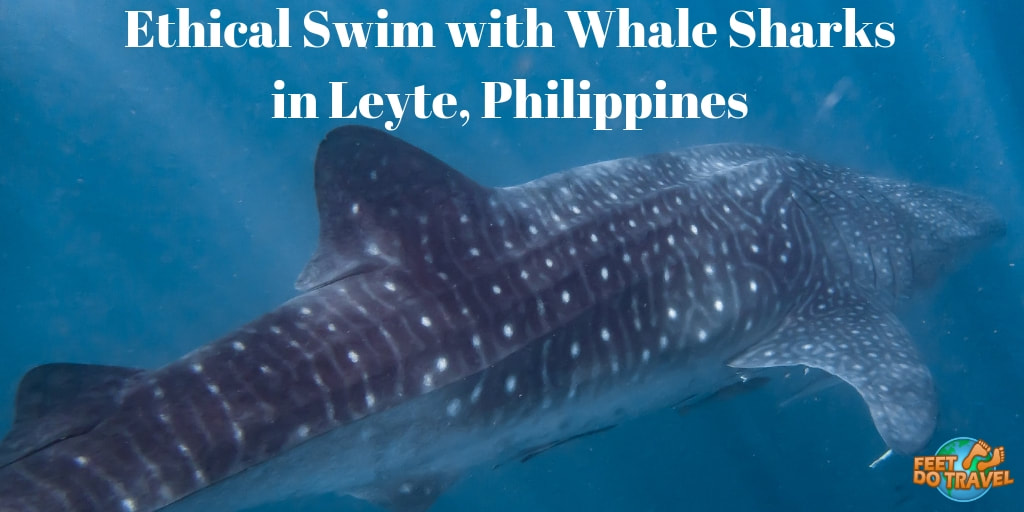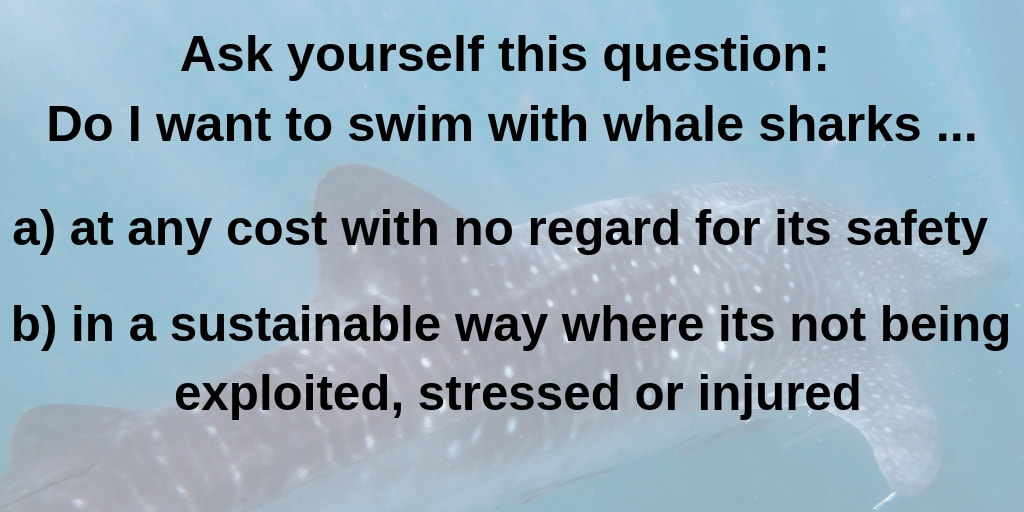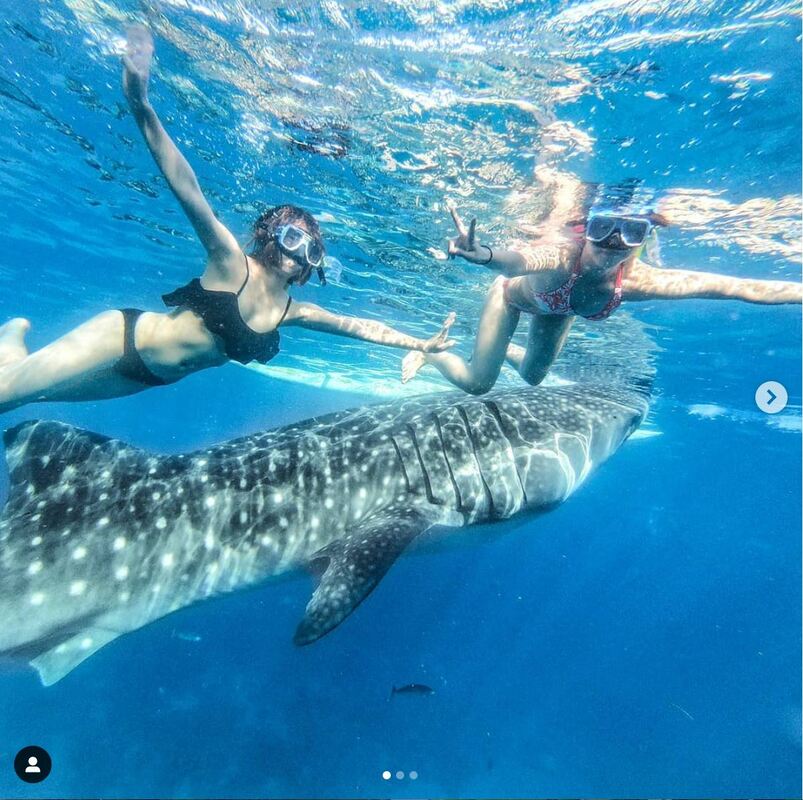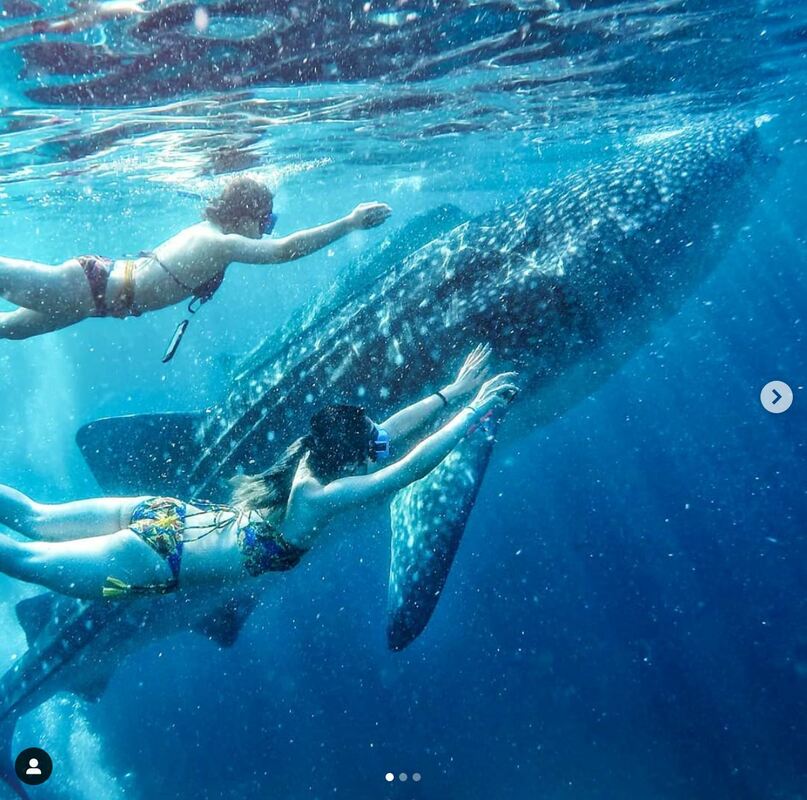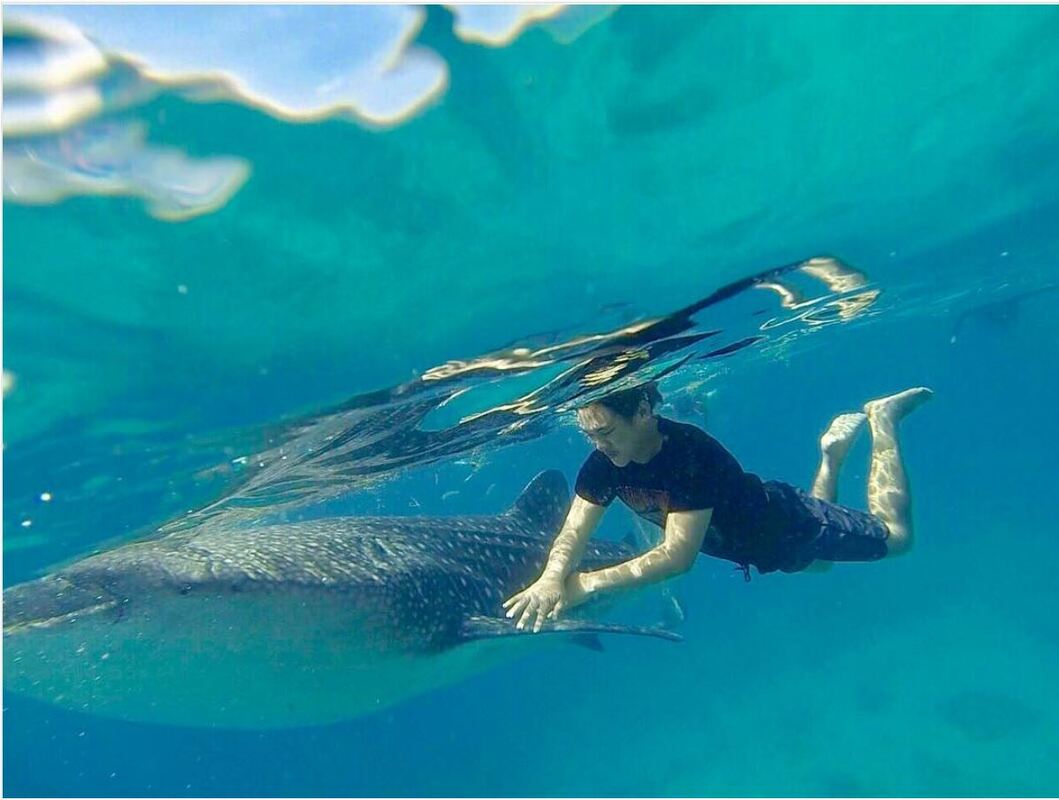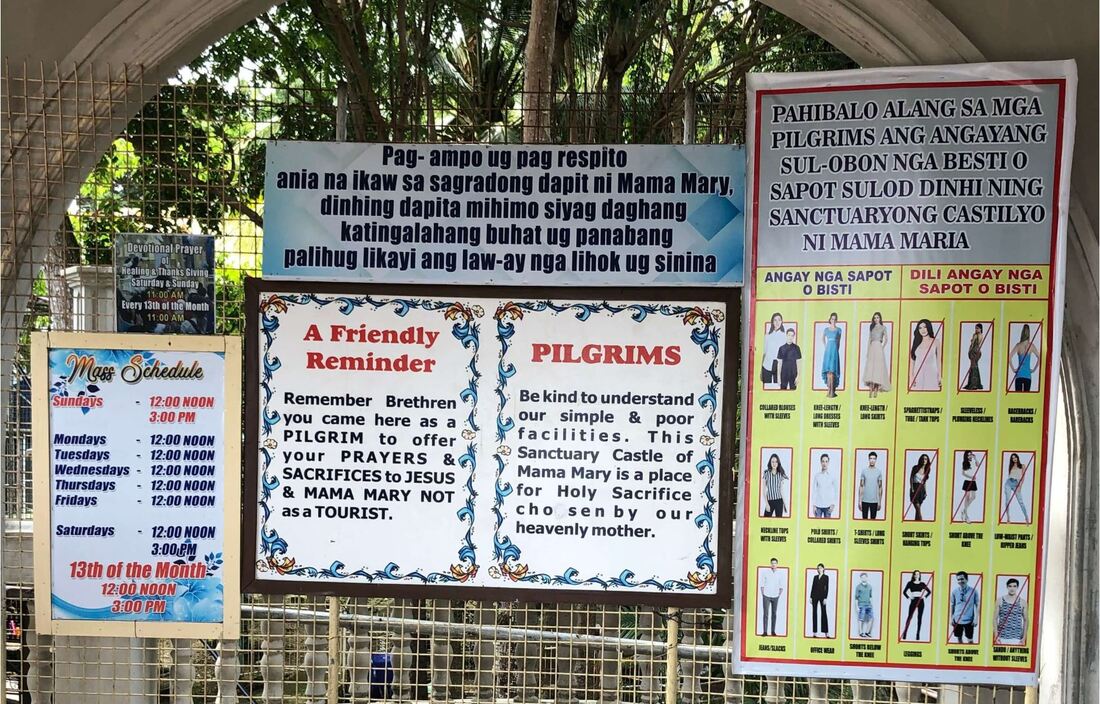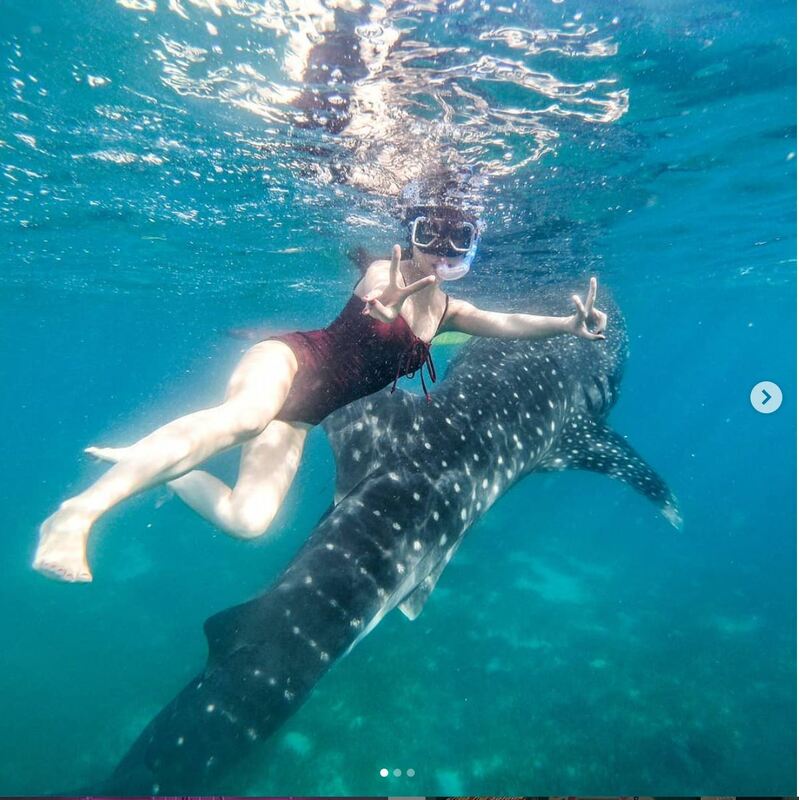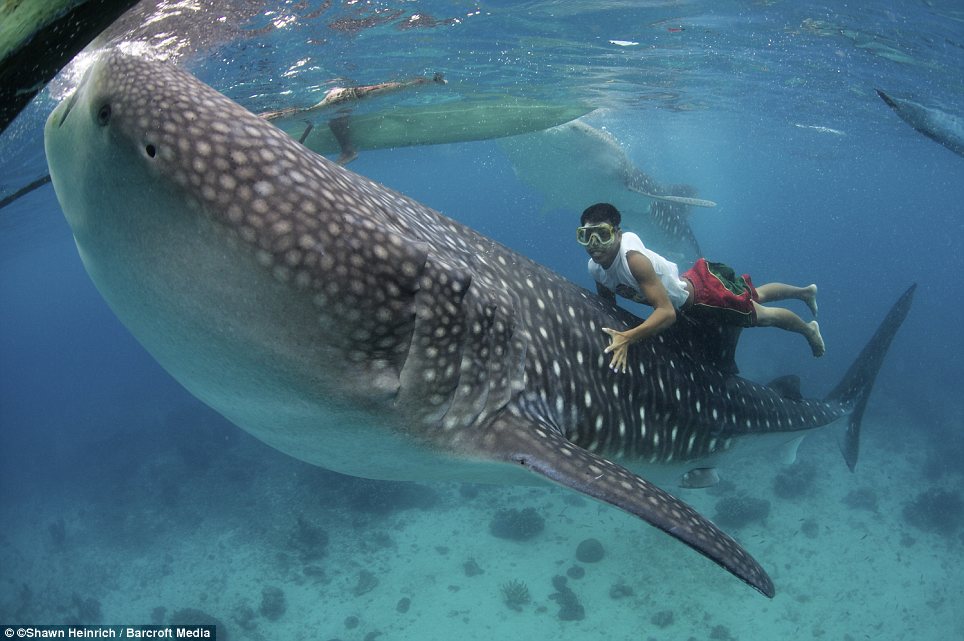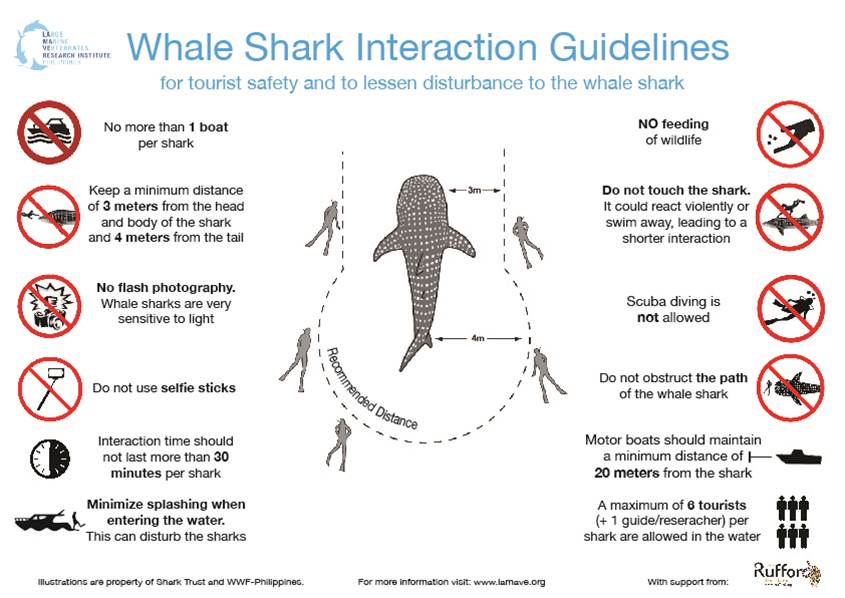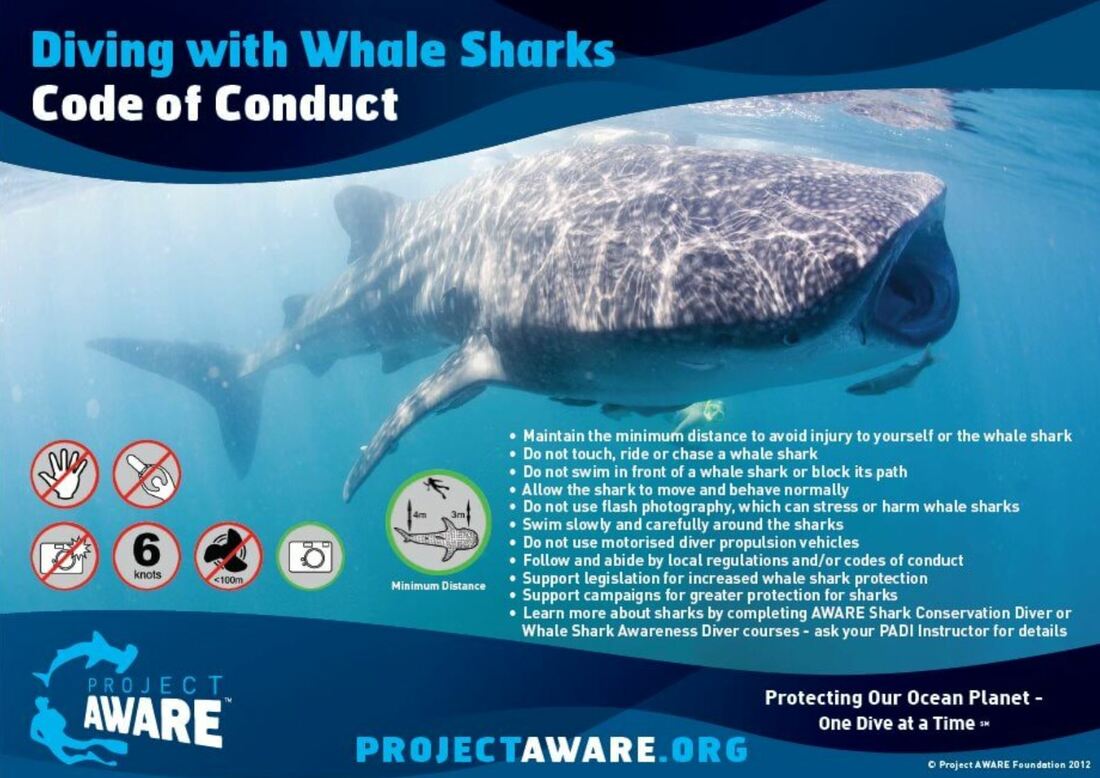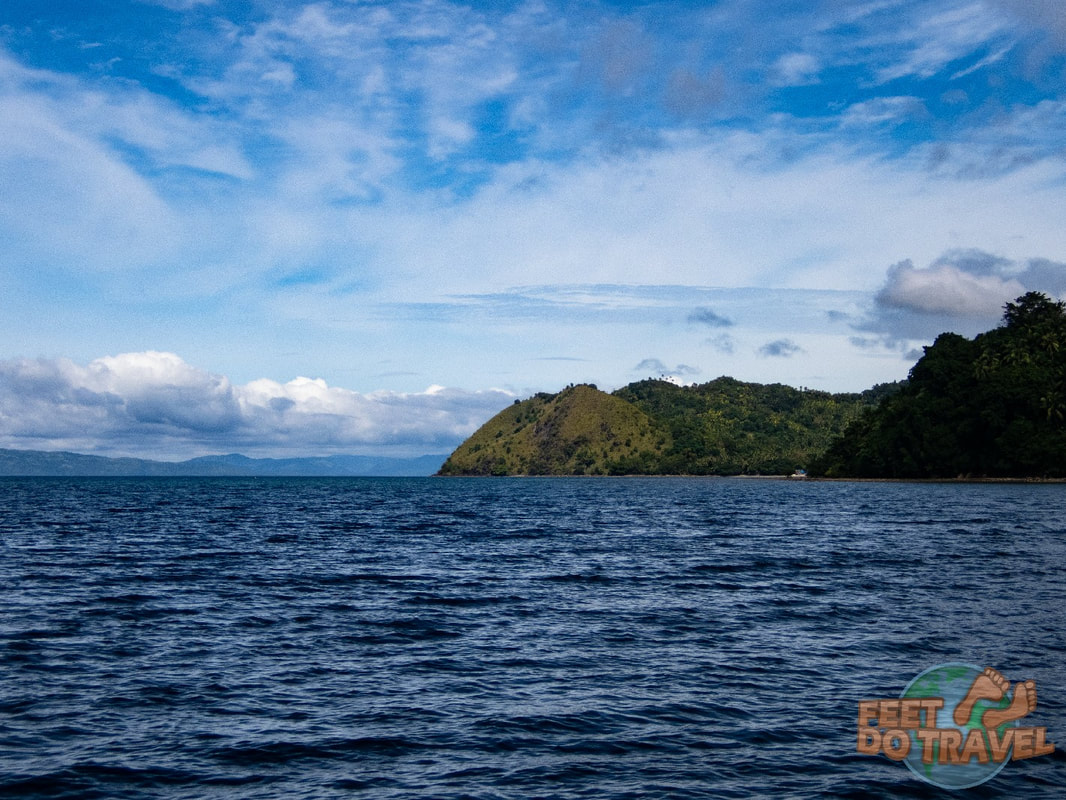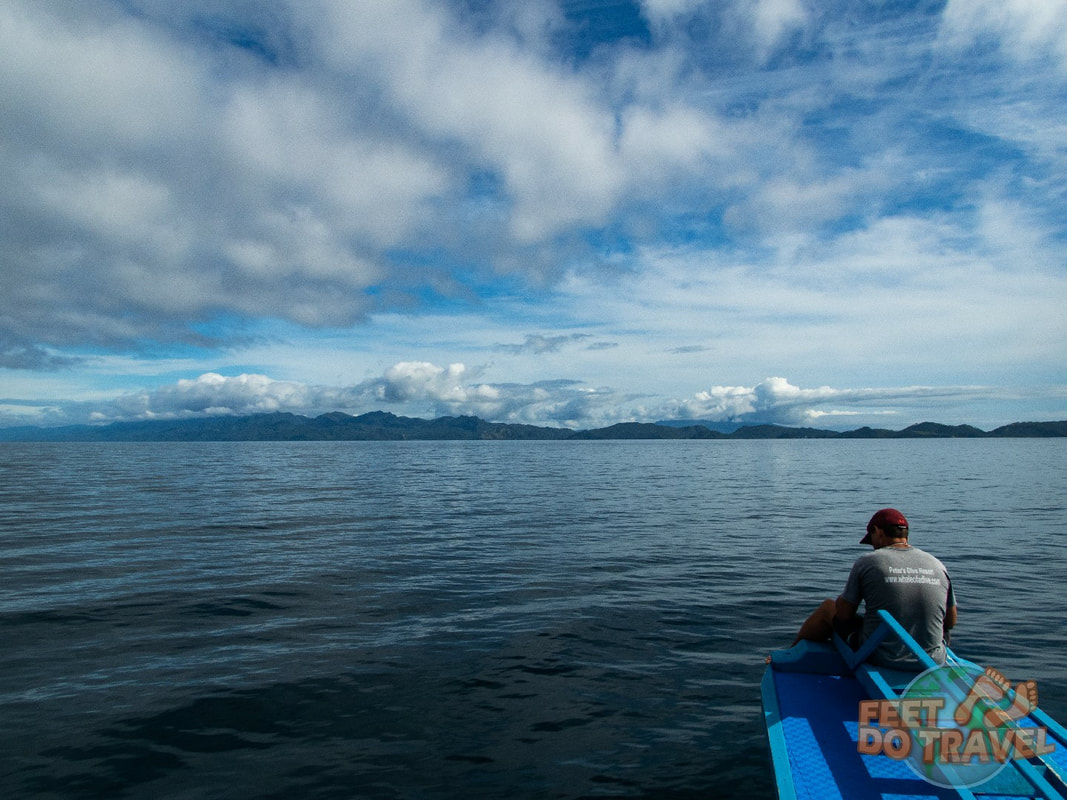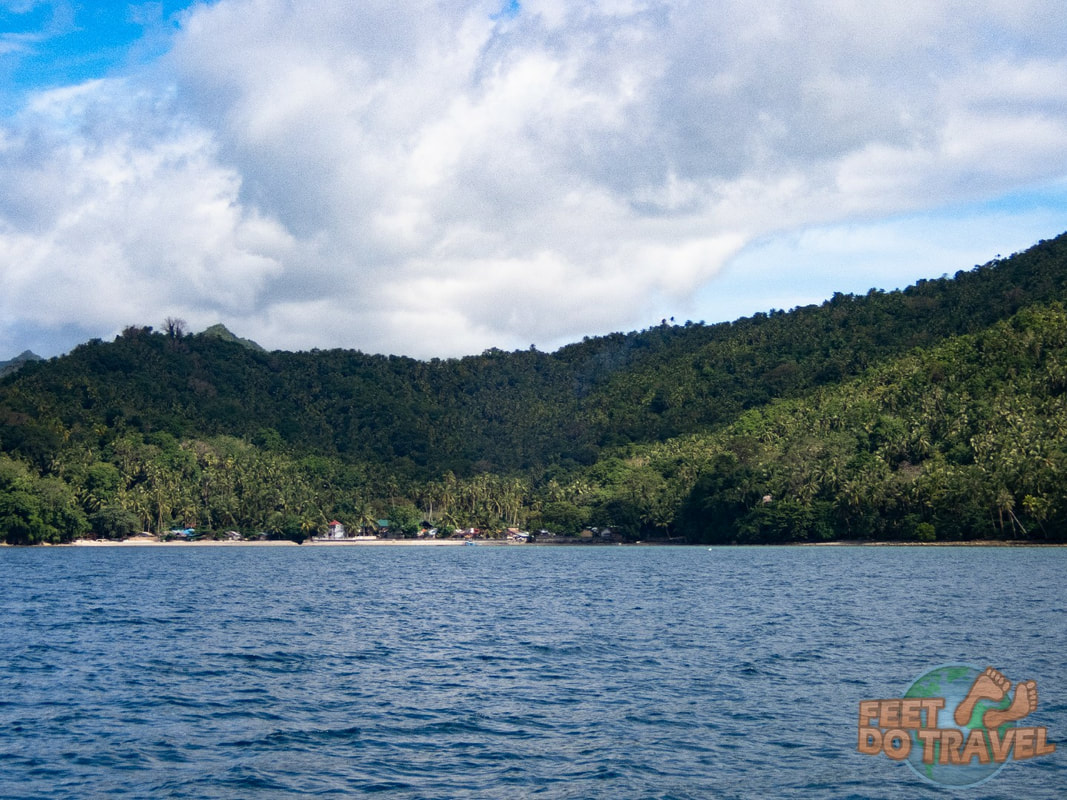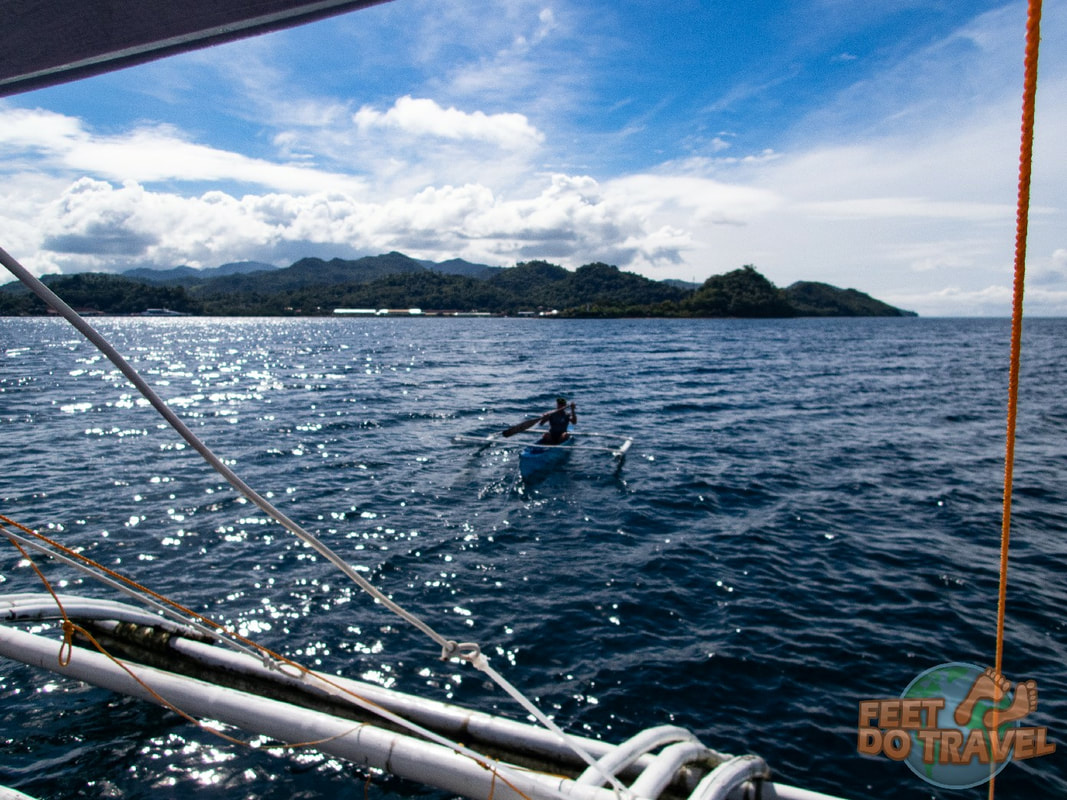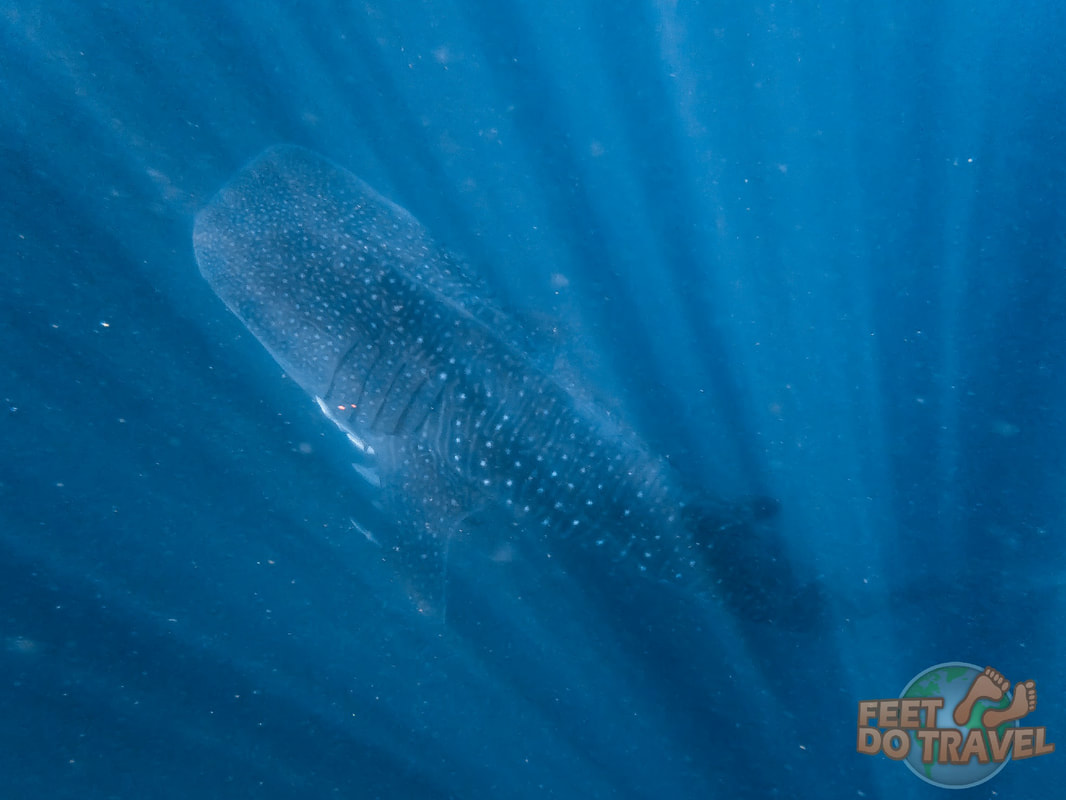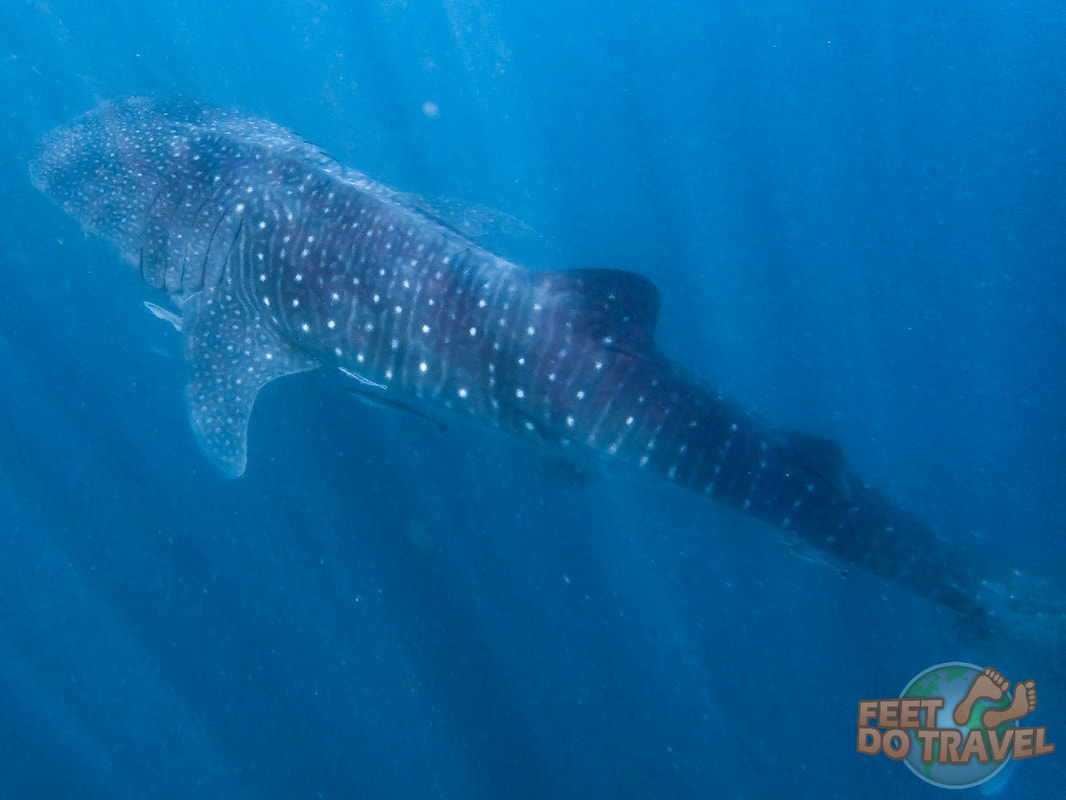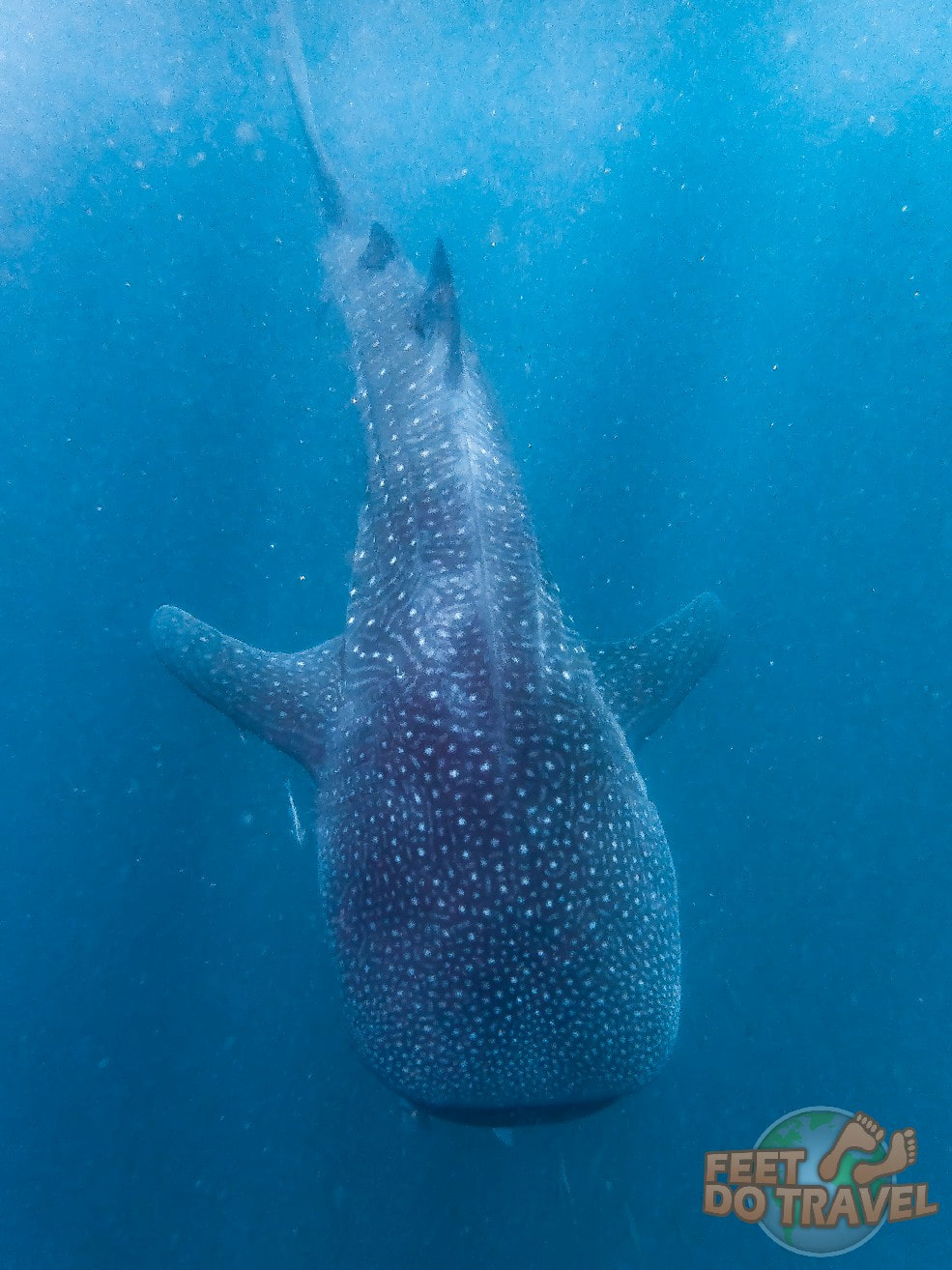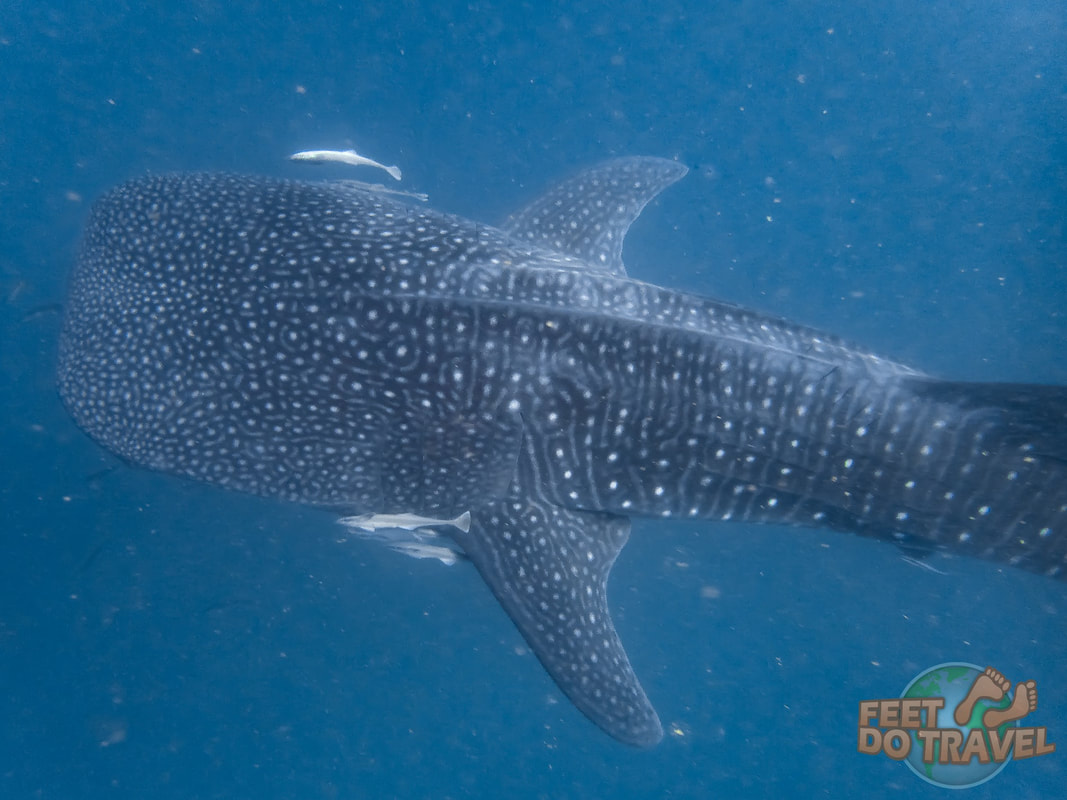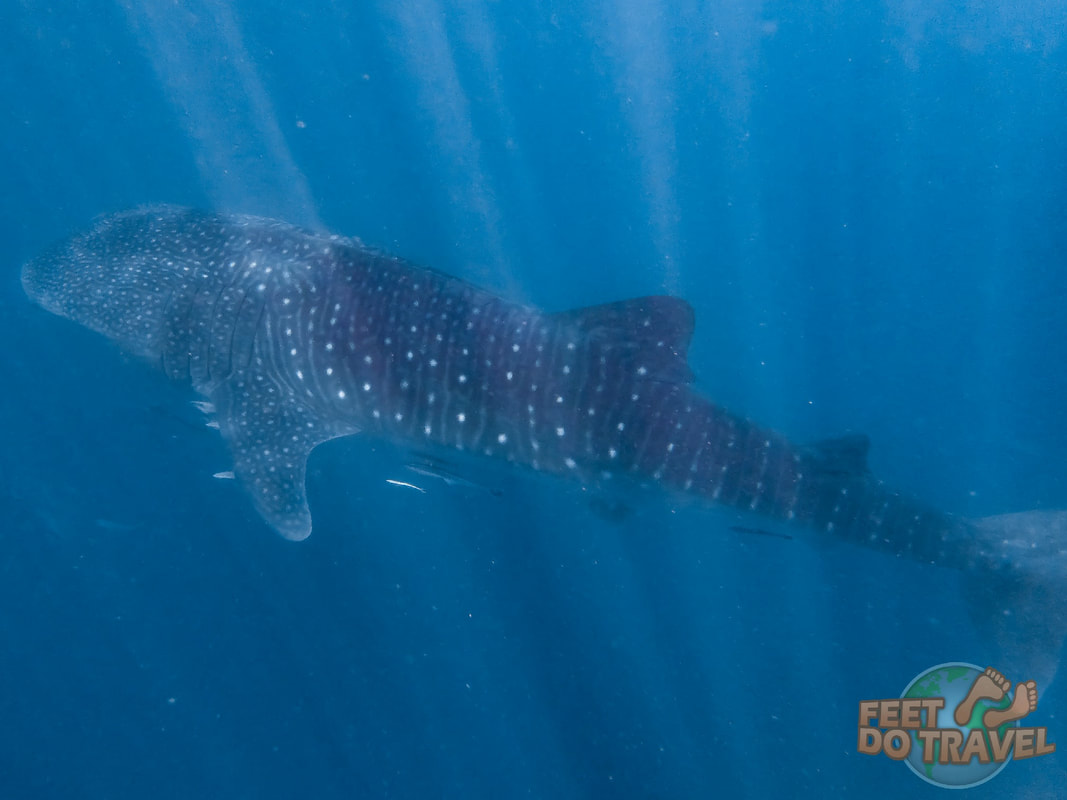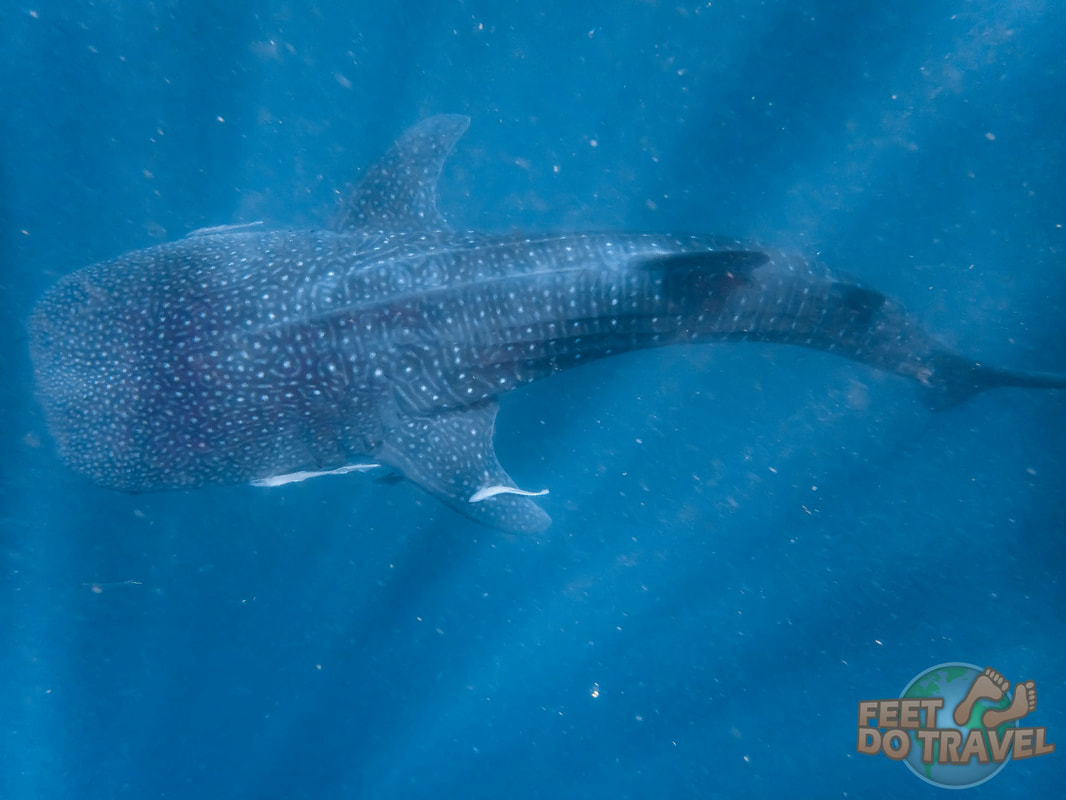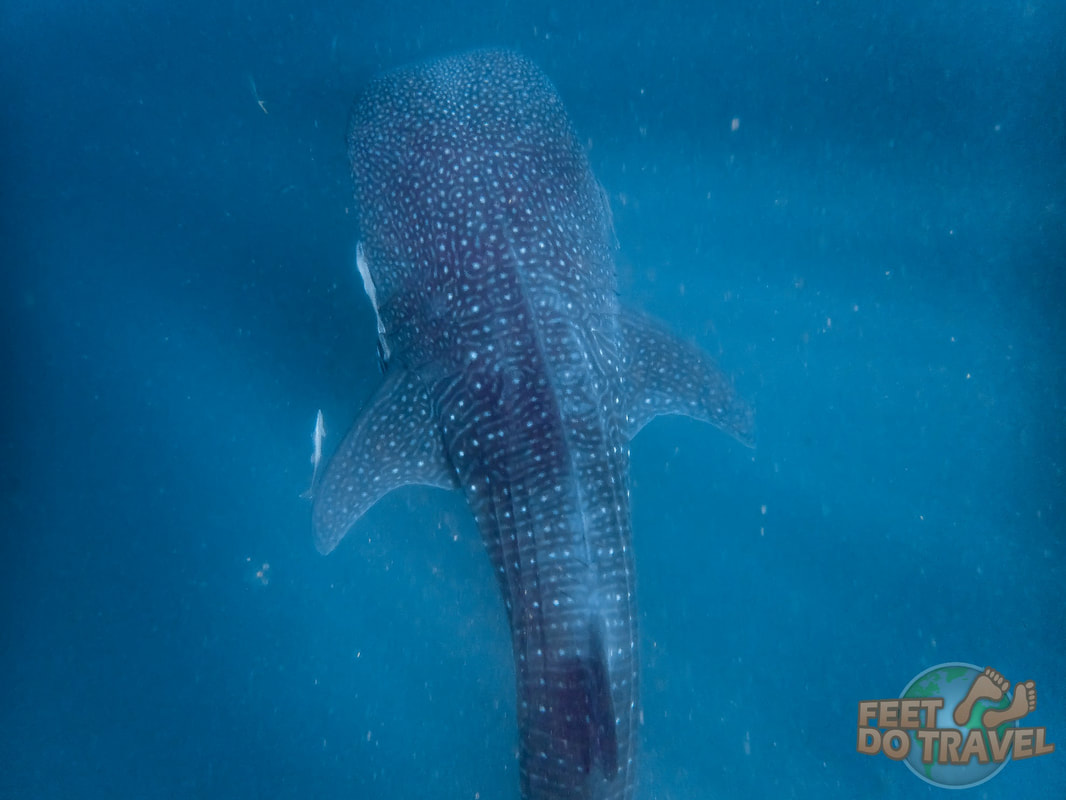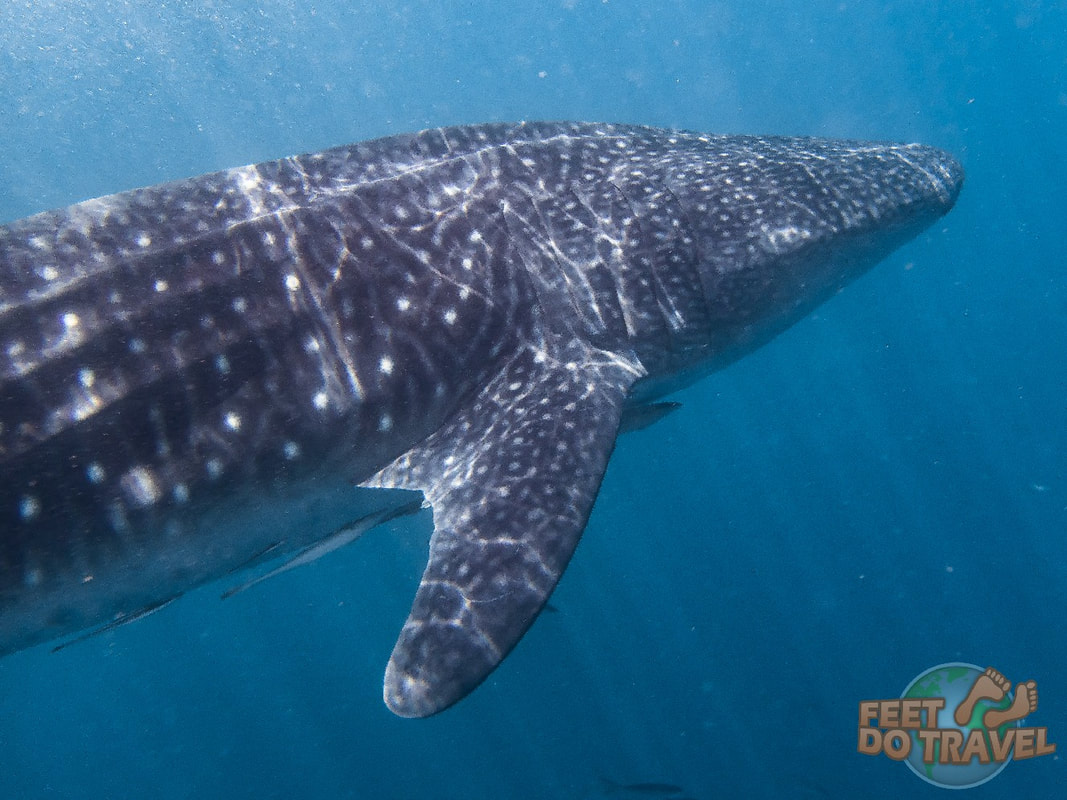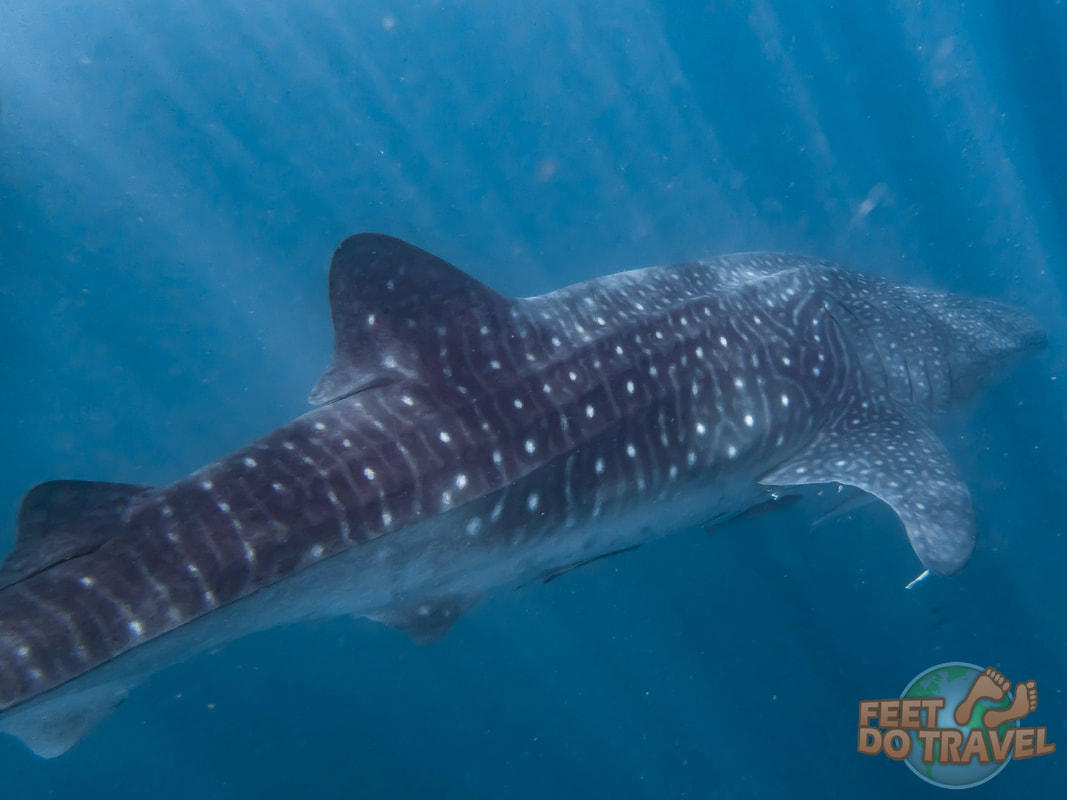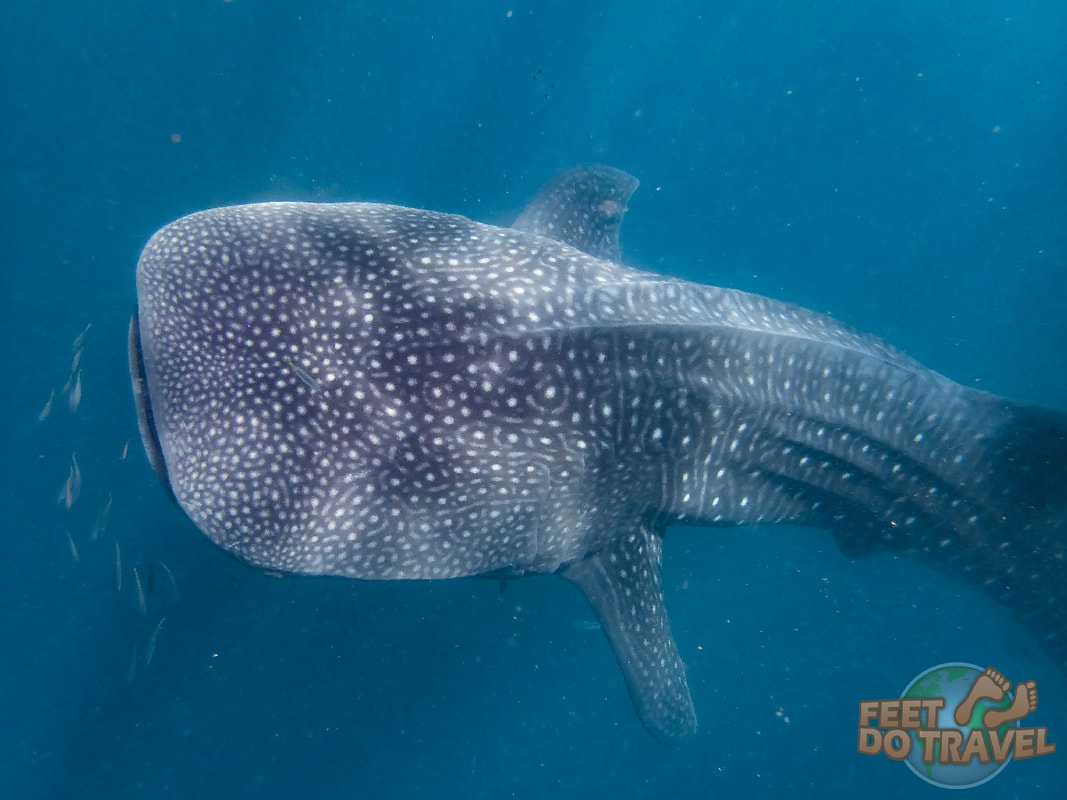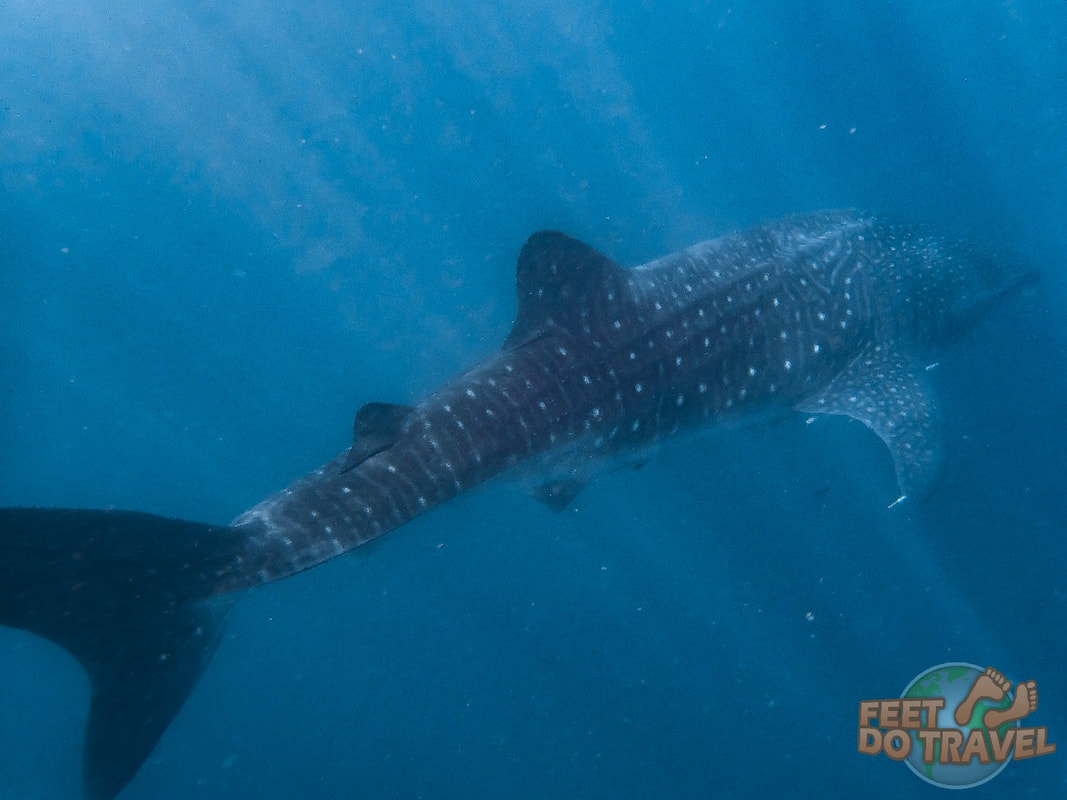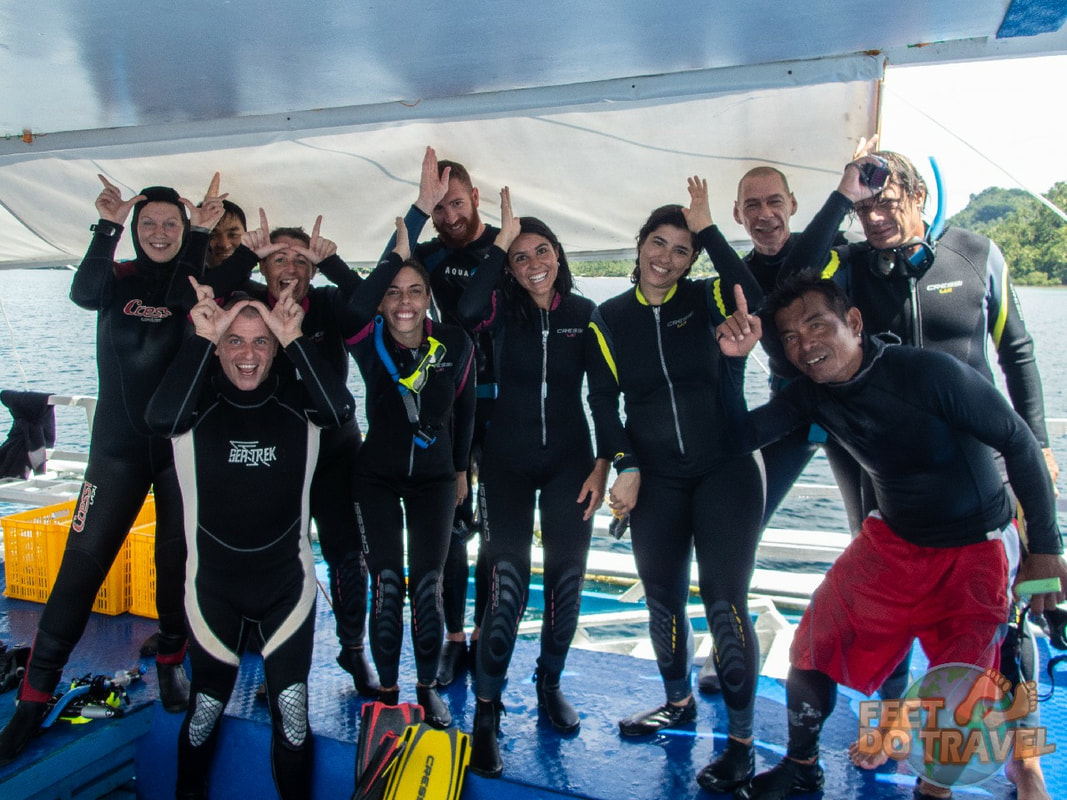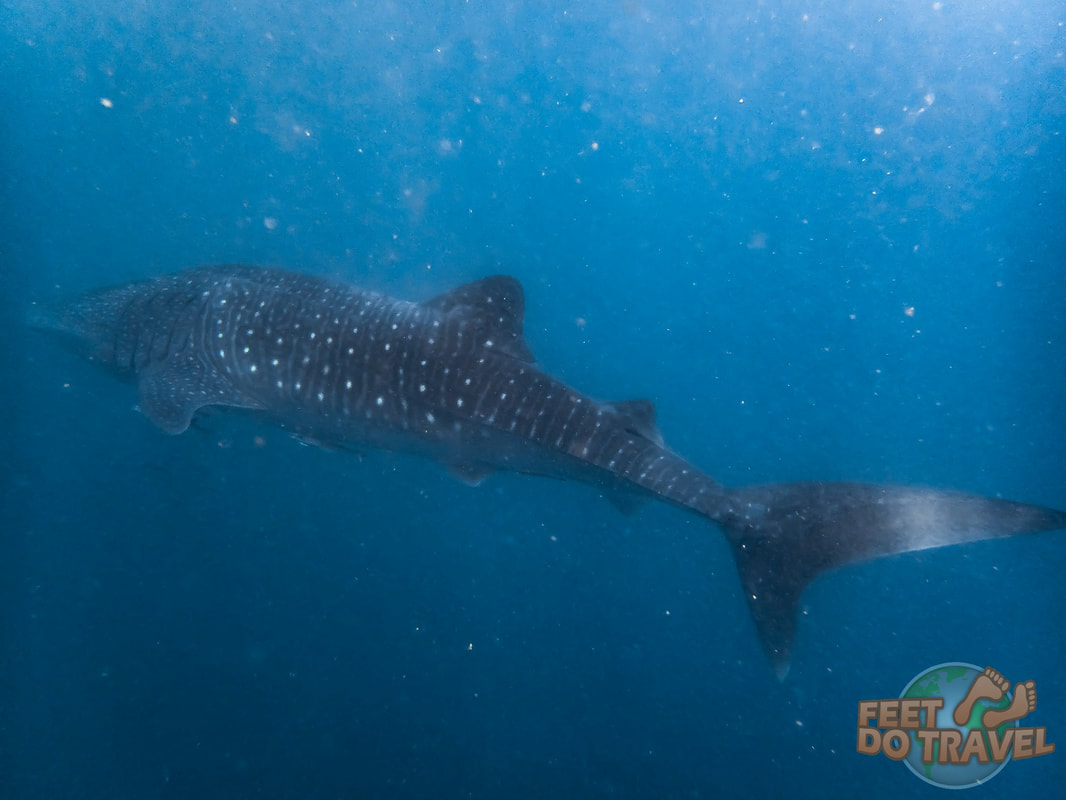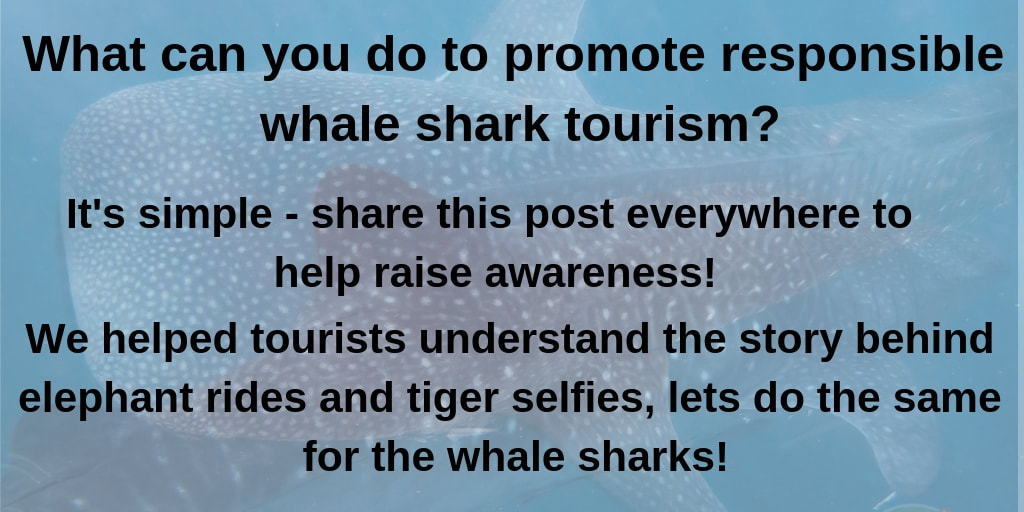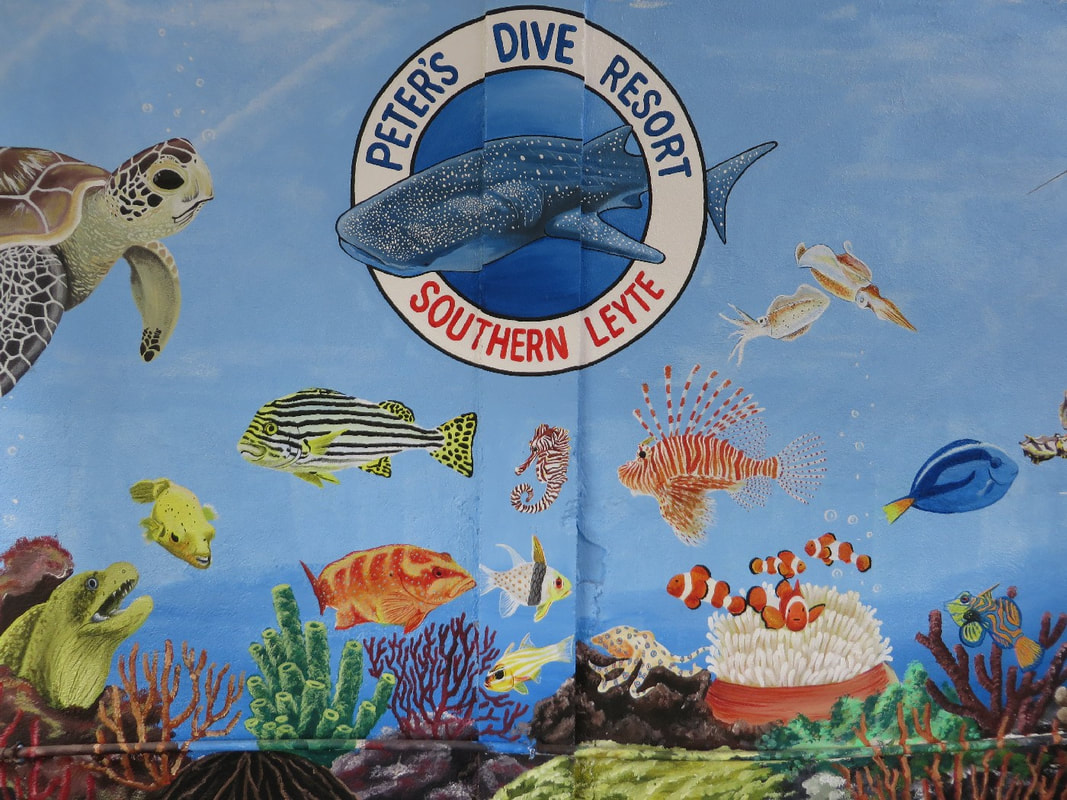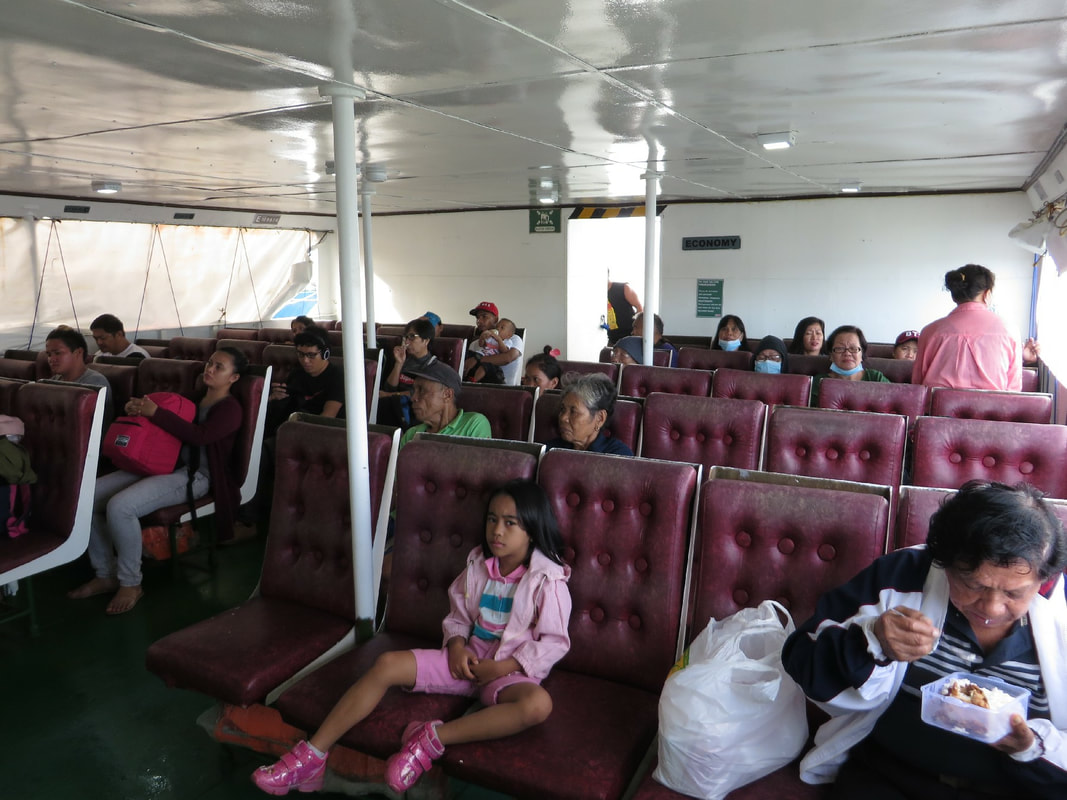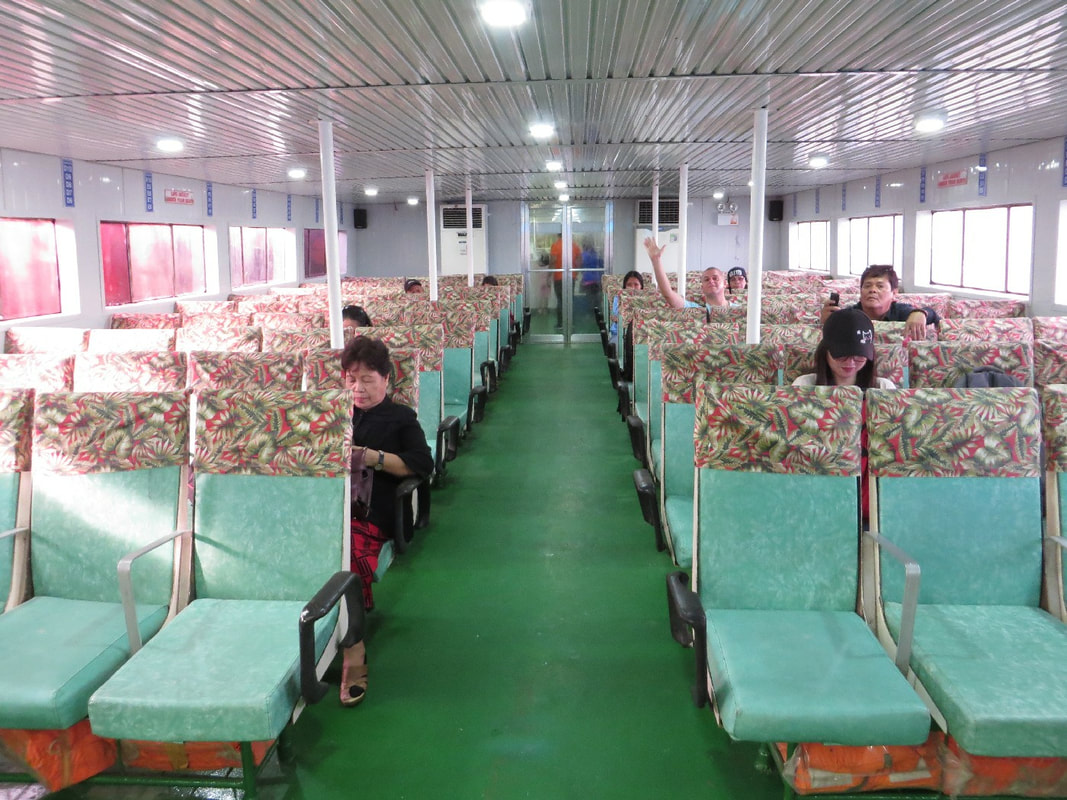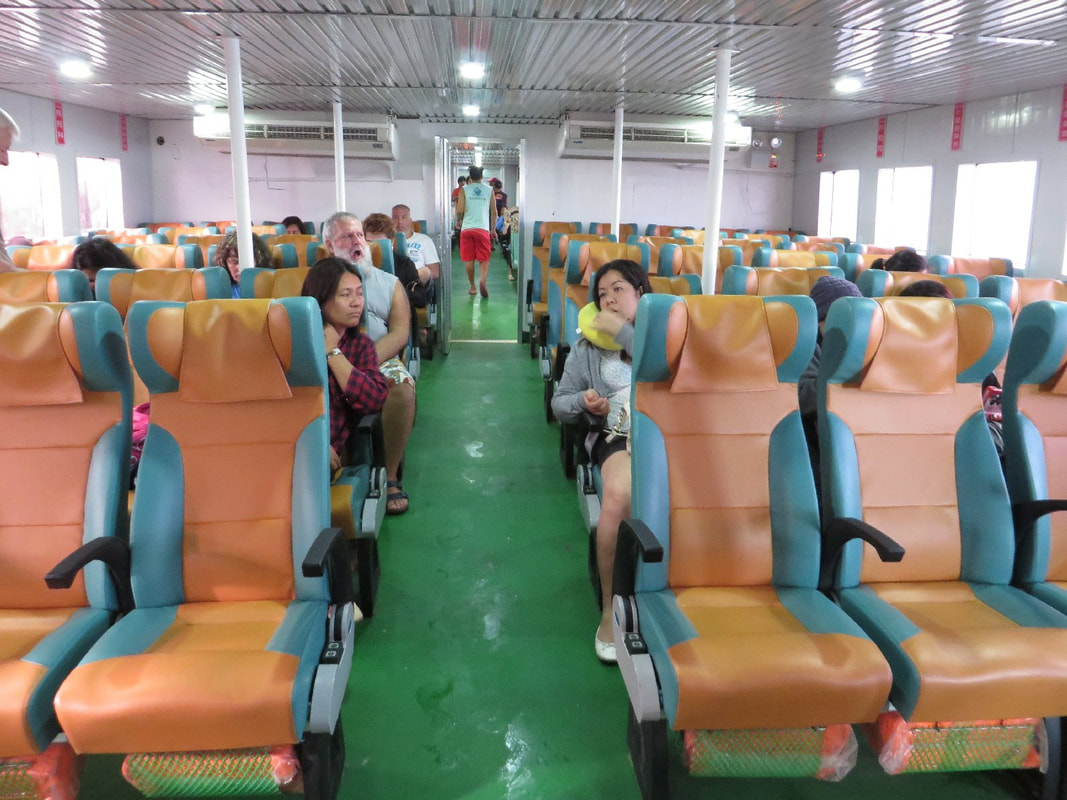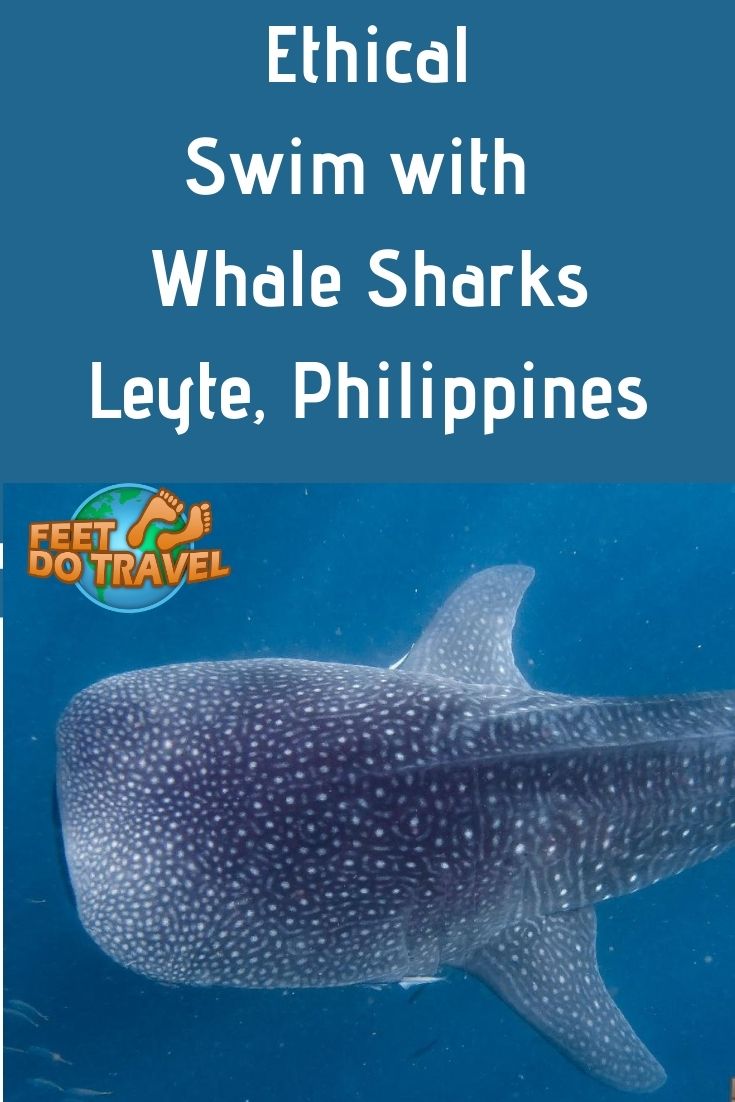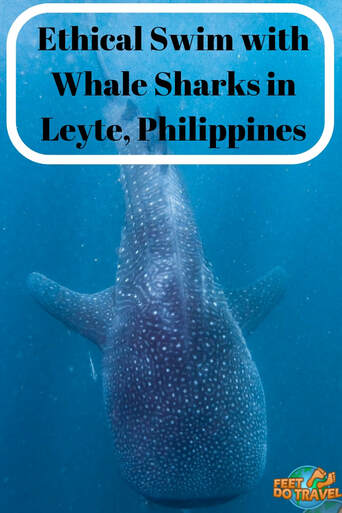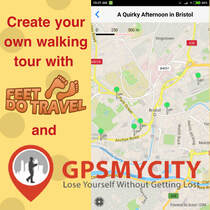In the Philippines you can swim with whale sharks in Oslob, Cebu where sightings are 100% guaranteed, but as a responsible traveller, we chose to visit Southern Leyte.
The reason? They offer the best place for whale shark watching in the Philippines in a natural, sustainable way. No feeding, no touching, no ticket numbers, no queuing up on a beach for two hours with hundreds of other people in the blazing sun waiting for your allocated slot, no man with a mega phone yelling that your 30 minute time is up.
Swimming and snorkelling with whale sharks in the Philippines is big tourism, and Oslob, Cebu has the most un-natural, circus style experience you can have. In contrast, Sogod Bay in Southern Leyte offered the most sustainable swimming with whale shark experience in the Philippines.
Feet Do Travel show you that it’s possible to swim with whale sharks ethically in the Philippines.
The whale sharks in Oslob account for 34.4% of the whale shark population in the Philippines, and this could have a long term negative effect on a species classed as “vulnerable to extinction”. We should not be gambling with their lives, their reproduction and their long-term safety when they are already endangered.
Some people believe/are told that if there wasn’t whale shark tourism in Oslob, the whale sharks would be killed as part of the global finning trade because that is how locals used to make their money, however whale sharks are protected by law and have been long before whale shark tourism.
In 1998, the Philippines was one of the first countries in the world to introduce the law protecting whale sharks from poaching, killing and selling whale shark products either dead or alive. Whale shark tourism wasn’t established until 2011, so for 13 years locals’ income was from fishing not finning.
In Oslob, or more precisely the small village of Tan-Awan where the snorkelling takes place, whale shark tourism means BIG money. It’s a lucrative multi-million dollar business receiving nearly 2,000 visitors PER DAY, some fisherman make up to P30,000 a week ($573/£438/E500) - the average weekly wage is P2,000 (Philippine Peso).
Tourism in Tan-Awan is only about the money and not about raising awareness about the sharks. Yes, shark tourism has changed the lives enormously for locals in this small fishing village, but sadly none of this money is re-invested towards shark conservation, and it is these gentle, curious giants who are paying the price for humans to live a better life.
Whales sharks can be seen in the Philippines all year round in a few places. Whale shark season in Donsol and Southern Leyte (which includes Padre Burgos and Pintuyan) is October to May. In Honda Bay, Palawan whale shark season is April to October. All offer ethical whale watching experiences and care about the sharks’ welfare.
If you speak to any marine conservationist, environmental advocate, ocean lover or responsible diver they will all tell you that snorkelling in Oslob, Cebu should not be done. In August 2018, National Geographic wrote an article regarding concerns over the impact of whale shark tourism in Oslob. The statistics quoted in this post have been reported by Marine Wildlife Watch of the Philippines, and LaMaVe, an NGO research and conservation company in the Philippines who have been conducting surveys since 2012.
As with most animal tourism, whale sharks are being exploited. They receive cuts and injuries from boats, and their natural behaviour has been altered which has an effect on the ocean’s ecosystem.
In December 2011, the UK Daily Mail Newspaper printed a photo of a man holding onto a whale shark, and the explosion of whale shark tourism in Oslob began.
1. The whale sharks are not receiving the right amount of nutrition from the frozen food fishermen are giving them. It’s the equivalent of humans eating french fries every day instead of a balanced meal. The fishermen’s aim isn’t to feed them, it is to give them enough food to keep them hanging around wanting more, so tourists pay to see them. A species as large as a whale shark needs a lot of food. This lack of nutrition is affecting their growth and reproduction, and they are already an endangered species. Whale sharks in Oslob are reported to be significantly smaller than those found in Leyte or Donsel where they are not fed by humans and have a natural diet.
2. 47% of Oslob whale sharks have received cuts and boat injuries. Within a week of a new shark arriving in Oslob, scaring and injuries were seen on their fins, mouths and bodies which is partly due to overcrowding in the water and partly because of their familiarity with boats. Whale sharks approach boats looking for food instead of swimming away from it, so if/when a whale shark leaves Oslob, it often mistakes the bubbles of a boat for food and they are hit by the propellers.
3. Feeding sharks teaches them that boats and humans mean food, this makes them an easier target for poachers. If/when the whale sharks leave Oslob, they travel long distances and with their new-found familiarity with boats, they are easier to catch in regions where sharks are caught for their fins, gills and meat.
4. They are spending too much time in the shallows being fed. Whale Sharks usually hang out around 50 metres and can dive as deep as 1,000 metres. It is believed they do this “to sleep”, to balance their body temperature and to rid themselves of parasites. By spending too much time at the surface makes them more vulnerable to disease, it heats their bodies and increases their stress levels. Stress in a wild animal can affect its survival as it changes the way they use their daily energy, how they grow, their immune system, reproduction and general health.
5. As a migratory species, they are spending too much time in one place, this means they are not following their usual migration routes and are missing out on mating and pupping grounds. An endangered species such as the whale shark needs all the reproduction opportunities it can get. One individual stayed in Oslob for 572 days, and “Mr Bean” for 392 days.
7. There are no restrictions on numbers at Oslob, and as many as 100+ people have been seen in the water around the whale sharks. This is stressful for the whale shark and will have an impact on its survival. Your experience will not be the personal encounter you envisage.
8. Guidelines are non-existent and the three metre distance rule isn’t enforced either by swimmers or boats. Feeders have been observed pushing whale sharks away with their feet in an attempt to discourage them from feeding.
9. There are no trained personnel to monitor or enforce the “no touching” law; Instagram and the internet are full of selfies showing people holding onto and touching the whale sharks. A survey by LaMaVe showed that on average a whale shark is touched 29 times every hour.
10. The whale shark is a protected species in the Philippines and it is illegal to harass them. In Oslob, they are breaking this law every single day. (The Republic Act 9147, for the conservation and protection of wildlife resources and habitats in the Philippines.)
Viewing whale sharks in Leyte doesn’t involve any human feeding them. Sightings are not 100% guaranteed (which is how any wildlife encounter should be) so there are far less tourists here, and you will not be sharing the experience with hundreds of other people. In Padre Burgos and Pintuyan, Southern Leyte you will probably be the only boat in the water (we were). But if whale sharks are not fed by humans, why are whale sharks found in Sogod Bay, Leyte?
Food is the reason but in a natural way. Whale Sharks are a migratory species who travel great distances following the food trail, often traversing entire oceans. Between November and May it is considered “whale shark season” and the whale sharks visit Leyte for a good sized meal.
Whale sharks use Sogod Bay as a feeding station and the plankton rich waters offer plenty of sustenance after their long journey.
Whale sharks enter the Philippines from the Pacific at two main entry points; the San Bernardino Strait between Luzon and Samar (for the Donsol whale shark sightings), and the Surigao Strait, between the Bohol Sea (also known as the Mindanao Sea) and the Leyte Gulf.
Our day started with anticipation. A slow passing typhoon the day before had postponed our day’s trip and today was our last opportunity of seeing them.
We set off at 8.30am from our accommodation at Peter’s Dive Resort in Padre Burgos, a 45 minute journey across Sogod Bay. All 12 of us on board were laughing and joking, all hopeful that we would be lucky.
When we arrived at the stretch of water where snorkelers had seen two whale sharks in the shallows a few days before, the captain cut the engine. The boat master explained how events would unfold; we should all gear up, sit on the side of the boat and wait whilst a spotter went out in a baroto searching for whale sharks. When he found one, he would give the signal to jump in one by one and make our way behind the boat. When we saw the whale shark, we were to stay a respectful four metres away and not use flash photography otherwise it will scare him away.
Now all we had to do was wait.
10 minutes passed by, 20 minutes, we were all staring out at the horizon looking up and down waiting for a large shadow or the end of a big tail penetrating the surface.
We had been up and down the shallows, we were now out in the blue where whale sharks can dive as deep as 1,000 metres. Generally, whale sharks stay around 50 metres – this is deeper than any recreational diver can reach so we just had to hope one would rise to the surface to filter feed on plankton.
I could almost feel the opportunity passing us by, it had been nearly an hour, surely we would have seen one by now?
My prayers had been answered. The unmistakable large shadow of a whale shark passed next to our boat. Everyone jumped in one by one, I had to put my darn fins and mask back on as I had popped to use the toilet!
Two others and I stopped swimming, our lungs were burning and we had run out of energy. We knew it was pointless to continue and with a heavy heart, knowing this could possibly have been our one and only chance, we took off our fins and climbed aboard our boat to pick up the others.
Rising from its deep position in the cobalt blue water, we could all see him clearly.
Rays of sunshine penetrated the water and he swam along slowly so we could have a good look. I say slowly, it was slowly for a whale shark but we were all swimming at a good pace. We were all getting a darn good workout today.
He moved effortlessly with so much grace, a few remoras hitching a ride on his underbelly.
That is the beauty of nature, and exactly how it should be.
I know I am not the only person who is now in love with this gentle giant after seeing it so gracefully gliding through the water. This encounter will stay with me forever.
Yes, I want to do this again!!
The first time I ever saw a whale shark was when watching sunset with a friend at Panagsama Beach, Moalboal, Cebu. We noticed hundreds of anchovies breaching the shore, a few minutes later someone yelled “Whale Shark!!!” and pointed to the shallows.
A whale shark was feeding on the anchovies but all I could see was the long-ish tale poking out of the surface. “Isn’t that a Thresher Shark because of the tail” I asked – nope, it was definitely a whale shark, in fact there were a couple.
Everyone jumped into the water with masks and fins spending about 15 minutes with the whale shark as it gorged himself on anchovies. Alas, I didn’t get to reach it quickly enough, but others around me did.
Donsol is also another ethical place to swim with whale sharks, and a natural feeding station on the sharks’ migration route. Donsol is more popular than Southern Leyte and there are more boats, however the experience is still sustainable with no feeding.
Honda Bay, Puerto Princesa, Palawan has a different whale shark season running April – October.
Tubbataha is also near Puerto Princesa, however it can only be accessed via a live-a-board. Tubbataha is a protected UNESCO World Heritage Site in a remote area.
Despite my burning desire to see whale sharks, even though Oslob was just two hours down the road from where we were living in Moalboal, the only way my conscience would allow me see one was in a natural way.
Share this post with friends, family, associates, on social media – share everywhere and help spread the word!
If reading this post has taught you that whale shark watching in Oslob is not sustainable for the long-term survival of the species, and that there are ethical places for your whale shark encounter – then please, PLEASE SPREAD THE WORD.
In the same way tourists were alerted to how bad animal tourism is for the elephant and tiger, and the sad truth behind those “animal selfies”, let us do the same for whale sharks.
Whale Shark Facts and Trivia
- International Whale Shark Day has been celebrated annually on 30 August since 2012. Make a note in your calender!
- Whale Sharks are the largest member of the shark family but are very docile and possess no threat to humans. Despite their name, size and appearance, they are not part of the whale family.
- In the Philippines, whale sharks are called Butanding.
- Whale Sharks have been protected from shark finning under Philippine law since 1998.
- Whale sharks are featured on the back of the 100 peso bank note.
- They are filter feeders and sieve plankton through their gills, but also sieve squid, krill, anchovies and other small fish.
- They have about 3,000 tiny teeth (less than 6mm long) in their giant 1.5m large mouth, but they do not use these to feed.
- A Whale Sharks’ spot pattern is unique to each shark, just like a human fingerprint.
- The average length of whale sharks found in coastal areas is between 4 – 8 metres, however the largest ever recorded was 12.65 metres (41.5 feet).
- Despite being slow swimmers (around 5km an hour), they cover huge distances. An adult female (named Anne) was tracked travelling 20,000km.
- They swim by moving their bodies side to side, unlike other sharks who swim using their tail.
- They can dive as deep as 1,000 metres but prefer to live around 50 metres – deeper than a recreational diver can go (which is 30 – 40 metres depending on their training).
- Whales sharks can live to 100-150 years old.
- They start to reproduce around the age of 25-30 and a pregnant shark can carry up to 300 pups giving birth to live young which are around 60cm long.
- Whale Sharks’ safety are threatened by the illegal global shark fin trade, and are considered to be one of the most vulnerable marine species in the world.
There are only a few places in Southern Leyte if you want an accommodation/snorkelling experience. We chose Peter’s Dive Resort, Padre Burgos and as scuba divers, staying in a dive resort suited us perfectly. They have a range of accommodation to suit every traveller and budget, and for non-divers, there is excellent snorkelling at their house reef a swimming pool and small outside gym.
If you want to know when Peter’s Dive Resort are running their whale shark trips, send an email as they respond quickly to messages and are very helpful in providing information.
By Air to Tacloban (Daniel Z. Romualdez airport)
The two main ports of entry into the Philippines are Manilla and Cebu. Daily domestic flights are available to Tacloban, north Leyte with Cebu Pacific and Philippines Airlines. A private transfer can be arranged to take you to Peter’s Dive Resort, the journey time is approx. 3-4 hours.
By Boat from Cebu:
General list of Ferry Schedules - www.schedule.ph
RoRo = Roll on roll off which means you can take a scooter or other vehicle
There are 8 different companies leaving from 6 wharfs from Cebu to Leyte, this equates to over 80 options, so I will only list the best choices. As with all boat trips, departure times and journey times can change, boats may even be cancelled due to bad weather. It is best to check the company websites ahead of travel.
A terminal fee of P25 per person is payable from Cebu City, and the ticket office closes approx. 36 minutes before the boat is due to leave (they say 30 minutes, but take their time from a clock which is wrong and refuse to sell you a ticket once they have closed the bookings).
Cebu to Massin – From Pier 1
This is your quickest option. If the fast ferry is running it takes around 3 hours, the regular ferry takes 6 hours. Peter’s Dive Resort is around 45 minutes away from Massin.
Fast Ferry - Weesam Express – Daily at 6am
Website: www.weesam.ph
Cost: Economy P600; Tourist Class P700; First Class P800
Regular Ferry - Cokaliong – Every Sunday, Monday and Wednesday at 12noon and 7pm
Website: www.cokaliongshipping.com
Cost: Economy P400; Tourist Class P600; Business Class P900
Transfer to Peter’s: A private van can be arranged for 1,000PHP per van (not per person).
Cebu to Hilongos – From Pier 3
This is your next best option. The semi-fast ferry takes 3.5 hours, the regular ferry takes 5-6 hours. Peter’s Dive Resort is around 1.5 – 2 hours from Hilongos.
Semi-Fast Ferry - Gloria G-1 – Daily at 2pm
Website: www.superferry2go.com/gabisan-shipping-schedule-rates-cebu-to-hilongos-and-vice-versa/
Cost: Economy P320; Tourist C P380; Tourist B P450; Tourist A P480 (see photos below)
Fast Ferry – Roble Shipping – Daily at 6am
Website: www.robleshipping.com
Cost: Economy P550; Tourist with Aircon P650
Regular Ferry - Roble Shipping – Daily at 12noon
Website: www.robleshipping.com
Cost: Economy B P265; Economy A P275; Deluxe – P310 & P330; Tourist P370; Cabin P585
Transfer to resort
Budget: You can book your seat on a shuttle bus to Padre Burgos when on board your ferry. Pay for your ticket on the bus and tell them you want Peter’s Dive Resort, they drop you at the door.
Cost: 110PHP per person
Comfort: Ask Peter’s to arrange a private transfer if you are arriving/leaving early/late
Cost: 1,800PHP per van (not per person)
Philippines Travel and Visa information
- Language – English is widely spoken to an excellent standard.
- Currency – Philippine Peso, £1 = 70 PHP
- Plugs & Electricity – 2-pin plugs (same as US/Canada/China/Japan, flat parallel, also known as Type A). Some places are also Type B (same as UK) and Type C (known as the “Euro” plug) Standard voltage is 220 V and the standard frequency is 60 Hz.
- Wi-Fi – Available mainly in the restaurant
- ATM’s – There is no ATM in the area, but Peter’s Dive Resort accept VISA and Mastercard at no extra charge.
- Driving – Right hand drive
- Visa - A 29 day free visa is given at the time of arrival. You can easily extend at a local immigration office for another 29 days, the nearest is in Cebu City.
- Airport – Tacloban is the nearest domestic airport in Leyte. Cebu Pacific and Philippine Airlines fly here. The nearest International Airport is Cebu City. NB. A Terminal tax is payable when you check in/before boarding on some International flights out of the Philippines. From Cebu the cost is 850 PHP.
- Religion – 80% Catholic
Disclaimer: This post contains some affiliate links. If you click through and make a purchase, it won't cost you any extra, the small commission we may earn will help support the FeetDoTravel community.


Care about Conservation and a nicer world? Check out these related articles!
Sardine Run, Moalboal, Cebu: Diving the Philippines
Tips for Living and Travelling with Less Plastic
Palm Oil Free and Sustainable Palm Oil Products for Men, Women and Travel
10 Easy Tips for a Green Eco-Friendly Christmas
Indonesian Orangutan Adventure
7 Easy Ways to Travel Plastic Free
World Ocean's Day: Conservation Success on GIli Air
Volunteering at Gili Air's Cat Clinic
Elephant Valley Thailand: Where Elephants Come First
Random Act of Kindness
10 Ways to Support World Ocean's Day
Siem Reap Pagoda Cats - Better than any Cat Cafe
Travelling around Asia? Check out these related articles
Diving in Dauin: Muck Diving in the Philippines
Unusual Things to Do in Singapore
20 Free Things to Do in Singapore
Singapore Street Art
Penang: City of Surprises
Penang Street Art
Mulu Canopy Walk - In the face of FEAR!
Critters & Caves at Mulu National Park
Brunei: The Green Heart of Borneo
Brunei Jungle - Primary Rainforest Paradise
Why You Should Visit Chiang Rai
Temple-Tastic Chiang Rai
My Chaing Mai
Temple Tour Chiang Mai
S21 and The Killing Fields - Why You Need to Visit
Street Art in Phnom Penh, Cambodia
Awesome Things to Do in Nusa Penida: Bali's Best Kept Secret
15 Things to Do in Canggu, Bali, Indonesia
Gili Air: The Perfect Island?
Gili Asahan: The Secret Gili Islands
Kuta, Lombok, the New Kuta Bali?
Spread the word about ethical whale shark watching!

